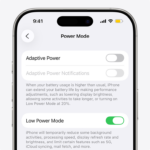The amount of RAM (Random Access Memory) an iPhone has is a key factor in how well it performs. Apple’s iPhone models have varied widely in RAM size since the introduction of the original iPhone. With each new iteration, from the first generation to the latest models, the increase in RAM has helped improve the ability to run multiple apps at once and enhanced overall system speed.
RAM plays a vital role in the functionality of an iPhone, affecting everything from app performance to system responsiveness. Understanding RAM is critical for users who want to get the most out of their device. As iOS becomes more advanced, the amount of RAM in iPhones ensures that users can enjoy a smooth experience with the latest features and updates.
iPhone RAM Size Guide (2007–2025)
iPhone (2007–2014): Early Generations
| Model | Year | RAM |
|---|---|---|
| iPhone (1st Gen) | 2007 | 128 MB |
| iPhone 3G | 2008 | 128 MB |
| iPhone 3GS | 2009 | 256 MB |
| iPhone 4 | 2010 | 512 MB |
| iPhone 4s | 2011 | 512 MB |
| iPhone 5 | 2012 | 1 GB |
| iPhone 5c | 2013 | 1 GB |
| iPhone 5s | 2013 | 1 GB |
iPhone 6–8 Era (2014–2017): Moderate Increases
| Model | Year | RAM |
|---|---|---|
| iPhone 6 / 6 Plus | 2014 | 1 GB |
| iPhone 6s / 6s Plus | 2015 | 2 GB |
| iPhone SE (1st Gen) | 2016 | 2 GB |
| iPhone 7 | 2016 | 2 GB |
| iPhone 7 Plus | 2016 | 3 GB |
| iPhone 8 | 2017 | 2 GB |
| iPhone 8 Plus | 2017 | 3 GB |
| iPhone X | 2017 | 3 GB |
iPhone XS–12 Era (2018–2020): Jump to 4–6 GB
| Model | Year | RAM |
|---|---|---|
| iPhone XR | 2018 | 3 GB |
| iPhone XS / XS Max | 2018 | 4 GB |
| iPhone 11 | 2019 | 4 GB |
| iPhone 11 Pro / Pro Max | 2019 | 4 GB |
| iPhone SE (2nd Gen) | 2020 | 3 GB |
| iPhone 12 / 12 mini | 2020 | 4 GB |
| iPhone 12 Pro / Pro Max | 2020 | 6 GB |
iPhone 13–15 Era (2021–2023): Standardization at 6 GB
| Model | Year | RAM |
|---|---|---|
| iPhone 13 / 13 mini | 2021 | 4 GB |
| iPhone 13 Pro / Pro Max | 2021 | 6 GB |
| iPhone SE (3rd Gen) | 2022 | 4 GB |
| iPhone 14 / 14 Plus | 2022 | 6 GB |
| iPhone 14 Pro / Pro Max | 2022 | 6 GB |
| iPhone 15 / 15 Plus | 2023 | 6 GB |
| iPhone 15 Pro / Pro Max | 2023 | 8 GB |
iPhone 16 Series (2024): 8 GB Across All Models
| Model | Year | RAM |
|---|---|---|
| iPhone 16 | 2024 | 8 GB |
| iPhone 16 Plus | 2024 | 8 GB |
| iPhone 16 Pro | 2024 | 8 GB |
| iPhone 16 Pro Max | 2024 | 8 GB |
(Confirmed via MacRumors)
iPhone 17 Series (2025): RAM Boost for Air and Pro Models
| Model | Year | RAM |
|---|---|---|
| iPhone 17 | 2025 | 8 GB |
| iPhone 17 Air | 2025 | 12 GB |
| iPhone 17 Pro | 2025 | 12 GB |
| iPhone 17 Pro Max | 2025 | 12 GB |
(Confirmed by Wccftech and Apple)
🧠 RAM Trends Over Time
- 2007–2012: Minimal RAM (128 MB → 1 GB) as iOS was lightweight.
- 2013–2017: Gradual increase for multitasking and better camera processing.
- 2018–2023: 4–6 GB became standard; Pro models began differentiating.
- 2024–2025: 8–12 GB standard, supporting Apple Intelligence and advanced AI features.
Key Takeaways
- iPhone performance is influenced by the amount of RAM.
- RAM sizes in iPhone models have increased over time.
- Understanding RAM is essential for optimizing iPhone use.
IPhone RAM Size Overview
RAM is a critical component of iPhones, impacting their ability to run apps smoothly and multitask. This section provides insights into how iPhone RAM has evolved, its effect on performance, and how it compares to competitors.
Evolution of RAM in iPhone Models
Apple’s iPhone models have steadily increased their RAM capacity over the years. From the modest 128MB in the original iPhone, Apple doubled this figure to 256MB in the iPhone 3GS and kept doubling until reaching 512MB with the iPhone 4. Recent models like the iPhone 11 Pro Max boast 4GB of RAM, which is significant when considering the efficient performance of iOS.
Impact of RAM on iPhone Performance
RAM size influences how many apps an iPhone can handle simultaneously and how quickly it can switch between them. Although iPhone RAM sizes are generally lower than those of some competitors, the integration of Apple’s hardware with iOS allows for a smooth user experience. Apps run efficiently, and performance remains consistent, even with multiple apps open.
Comparing iPhone RAM to Competitors
Comparing iPhones to rivals, the RAM sizes might seem smaller. However, iPhones often match or exceed the performance due to the optimized nature of iOS. For example, an iPhone with 4GB of RAM can perform as well as or better than competitors with higher RAM due to the power of the Apple ecosystem. It shows that raw numbers don’t always tell the full story in performance.
Technical Specifications and Functionality
This section sheds light on the importance of RAM in iPhones, how it links to the device’s multitasking abilities, and its role in relation with iOS updates.
Understanding RAM Specifications
RAM in an iPhone acts as the workspace for the processor to manage active tasks and run applications smoothly. Recent models like the iPhone 15 come equipped with 6GB of LPDDR5 RAM, which is a step up from older versions that offered lower capacities and slower types of RAM, such as LPDDR4X found in the iPhone 14 series.
RAM and Multitasking Capabilities
More RAM can improve an iPhone’s capability to handle multiple tasks at once. With ample RAM, users can switch between apps without slowdowns or loss of data. For example, the iPhone 13 Pro models with 6GB of RAM support better multitasking performance compared to the iPhone 8 Plus, which has 3GB of RAM.
Relation Between RAM and IOS Updates
As iOS updates roll out, they often come with features that demand more from the device’s hardware. Having a higher amount of RAM means that an iPhone will generally maintain a good performance level after these updates. It helps to make sure that newer iOS versions run effectively on older phones like the iPhone 12 which, despite its age, can still manage current software demands due to its adequate RAM size.







